To continue building on this impact, we launched a new blog property in 2019: The Website Blog. This blog is designed to educate readers on how to build and maintain a website and covers a wide range of topics, including WordPress, content management systems, web hosting, APIs, development, and more.
While the Website Blog has accumulated hundreds of thousands of sessions and keyword rankings since its inception, it has experienced particularly unprecedented growth from 2020 to 2021. Let’s take a closer look at how the blog grew in one year and the strategies that led to this growth below.
How much did the Website Blog grow in 2021?
The short answer: a lot. We more than doubled our blog traffic, tripled our page one keywords, and learned a lot about which types of content and topics our readers are interested in. Read on for the full story regarding how much we grew the Website Blog in 2021.
Note: This data reflects a one-year period spanning from September 1st, 2020 to September 30th, 2021.
Blog Traffic
Let’s rewind to September 2020, when our blog was just a year old and we were growing slowly but steadily. Things were looking good. Page views rose each month and we had just hit a record number of monthly sessions. We felt on top of the world, and we had the numbers to prove it. I mean look at this graph!
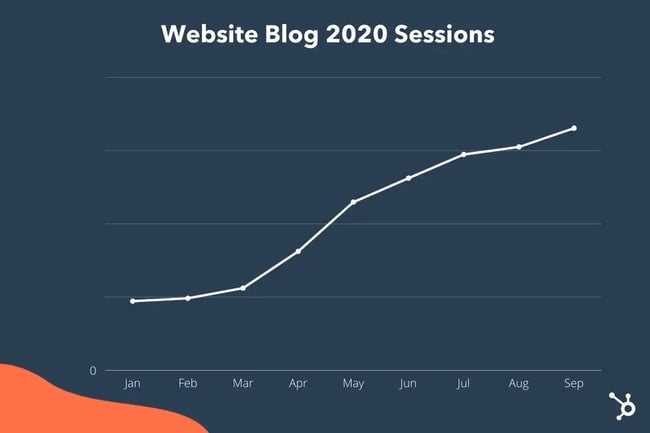
Fast forward a year, and we would never have anticipated the amount of growth that we experienced. We more than doubled our monthly traffic between September 2020 and September 2021 and saw more than a 100% year-over-year increase in total traffic which put us on track to outpace our big sister Service Blog by the end of the year.
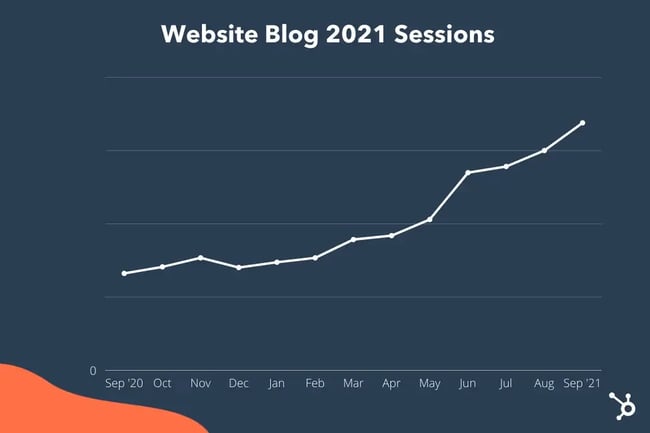
The majority of this traffic came from organic sources — meaning our visitors were finding us organically, through search engines. Our target audience was looking for answers to their website problems and found them on our blog. This is the core of our blog’s traffic strategy.
Search Engine Optimization (SEO) Rankings
Sessions are a great metric for measuring blog growth, but they don’t tell the full story. Our traffic strategy relies heavily on SEO and involves winning keywords that are relevant to our blog’s topic clusters, which we’ll talk more about later in this post.
In September 2021, our blog doubled the number of keywords that it ranked for on search engines — more keywords, more traffic. We also saw significant increases in our page-one keywords and doubled our keywords ranking in position 1-3.
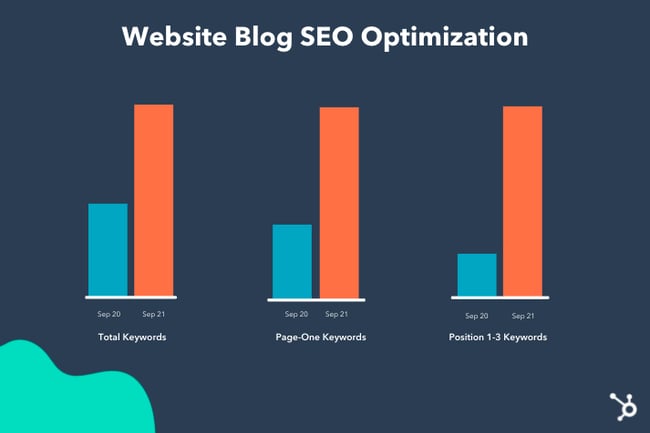
Keyword ranking is the biggest contributor to our blog’s growth. Not only are we creating content that targets specific keywords, we’re creating high-quality content that’s outperforming our competitors on the SERPs. By winning more page-one keywords, we’re gaining a lot of visibility to those who are searching for information that can help them build and manage a website.
Blog Audience
Part of our work this year involved not only increasing traffic to our blog, but also learning more about the people who read our content. We wanted to know more about these individuals, why they’re reading our blog, and what more we can offer them.
We discovered that our audience is primarily male, but more than a third of our readers identify as female. The majority of our audience falls between the ages of 18 and 34 and most users are from the United States and India. Almost all of our traffic comes from new readers and nearly everyone in our audience consumes our content on desktop devices.
Although we wouldn’t classify these findings as “surprising,” it’s important to keep an eye on these metrics for any changes over time. For instance, this year we had more female readers engage with our content than we did last year. We also saw our age demographic shift ever-so-slightly to an older audience. While these differences are subtle, it does show that your audience can change over time and you want to make sure you have a clear understanding of who you’re engaging with when curating your content.
For instance, the slight shift in female readership could be related to the new writers contributing to our blog. We’ve added two female writers in the past year, giving our content a more diverse perspective than we had in 2020. While we don’t think too hard about the gender of our target audience, it makes sense that our content is more inclusive now that we have a more diverse group of writers.
As for the change in age demographics, we should expect our audience to get older over time. It’s never been easier to build a website, and people of all ages can benefit from our content. You no longer need to know how to code if you want to build a website. You just need the right tools and a good instructor. As more people discover this, web building won’t just be a skill reserved for computer whizzes and IT specialists. Your mom, dad, uncle, aunt, and maybe even grandparent, will want to create a website because now they finally can.
How did we double traffic to the Website Blog?
As you might imagine, doubling traffic and tripling page one keywords for a blog property takes a lot of time and effort. There’s no magic bullet — it requires a range of best practices and investments. Below we’ll take a look at a few key factors that contributed to the accelerated growth of the Website Blog.
Organic Traffic Strategy
As previously mentioned, this isn’t our first rodeo. Using our Marketing, Sales, and Service blogs as models, we implemented a strong organic traffic strategy that we trust and believe in.
Our organic traffic strategy follows the pillar cluster model. Under the pillar cluster model, a topic area is anchored together by one web page — known as the pillar page — that provides a broad overview of the topic, which then links out to more specific, deep-dive blog posts based on related subtopics. Together, the pillar page and the deep-dive blog posts make up a topic cluster. This strategy enables our blog to achieve both depth and breadth on a topic, which improves our chances of ranking.
The Website Blog publishes content across several topic clusters targeting over hundreds of thousands of MSV per quarter. Here’s a look at one topic cluster featured in our latest editorial calendar:
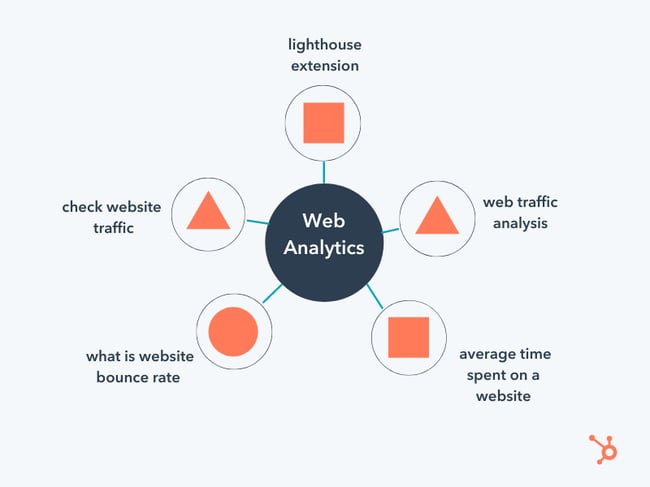
Freelancers and Guest Contributors
At the beginning of 2021, we only had two full-time writers contributing new content to the Website Blog. Since then, we’ve adopted a more aggressive strategy to content creation that includes a freelancer and guest contributor program.
Freelancers help us produce content that targets the keywords we want to rank for, while guest contributors provide a mix of search-optimized content and “buzzy” content. Buzzy content isn’t typically geared toward a keyword with high search volume — rather, it’s geared toward specific trends, events, and behaviors occurring in our industry that our readers are interested in, but not necessarily searching for organically.
A great example of a Buzzy post is the guest post, Top 10 Web Development Trends to Expect in 2021. While the primary keyword “web development trends” doesn’t have a significant monthly search volume, this post has netted thousands of views across organic, direct, email, social, and referral traffic channels.
Thanks to freelancer and guest contributors, both average content production on and traffic to the Website Blog has increased per quarter from 2020 to 2021.
Non-Organic Content
This year, we rolled out our first batch of “non-organic” content on the Website Blog. Similar to guest posts, non-organic posts target topics that don’t have much search volume, but are interesting and relevant to our readers. These posts might cover topics like bad website designs, WordPress trends, and accessibility statistics. Staying on top of trending topics like these helps establish HubSpot as a thought leader in our industry and supplements our organic traffic.
Historical Optimization
A key component of our blog’s organic traffic strategy is historical optimization. As our blog matures, some of our content naturally becomes outdated. Search volume changes for existing keywords, new keywords show up on our radar, trends emerge, stats need to be updated — all of these factors affect our ability to rank well on search engines. That’s why it’s critical that we constantly update our content. Now that we’ve started to see growth in our organic traffic, we need to continue optimizing our existing content so we can remain competitive.
WordPress
WordPress powers over 42% of websites on the internet and 65% of CMS-powered websites specifically. Since tens of millions of people use WordPress, it presents a huge traffic opportunity.
In a given month, WordPress topics account for a significant portion of our blog’s traffic. Here’s a look at our last two months of traffic data:
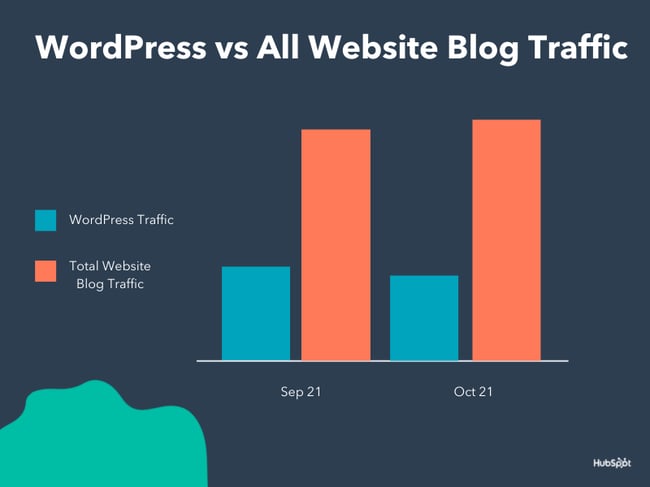
We’ve put a lot of work into building out our WordPress clusters, but there is still a ton of greenspace for us to pursue. Keep an eye out for more of this content in the coming months.
Website Acquisition
The Website Blog is the first HubSpot blog that began with a website acquisition. In early 2019, we acquired the WordPress blog, SourceWP.com.
The acquisition came with search rankings and organic traffic of its own that we were able to benefit from. As a result, the Website Blog was able to get up-to-speed quickly to compete in the SERPs. Rather than simply push this content live and leave it, our team optimized this acquired content according to our editorial guidelines over time. This helped us maximize these traffic gains, as shown in the chart below.

What’s next for the Website Blog?
Content Creation
Whether it’s 2021 or 20021, content creation will be a central part of our blog’s strategy. More content means more keywords for us to rank for which means more traffic for us to capture.
We’ll continue our organic traffic strategy by covering more topics within the topic clusters that we’re currently writing about. We’ll also start to tap into more advanced web development topics that a junior developer could find useful, or a digital marketer may be interested in as they improve their development skills. Look for us to cover more technical topics in the future that’s primarily geared towards web developers and marketers who manage a website full-time.
Increased Blog Bandwidth
Along with our guest and freelancer programs, we’ve also added new writers to our team. These writers have firsthand experience in web development and will help us cover those advanced technical topics that we mentioned earlier. Just like with our content creation strategy, more writers means a greater output for the Website Blog, which in turn should result in more traffic.
Historical Optimization
Being the youngest blog property, the Website Blog often gets referred to as the “baby blog.” Well, watch out Marketing and Sales because we’re not so little anymore. We’re quickly approaching our rebellious teenage years and we want some respect from our big sister properties.
And, just like getting the keys to the parents’ minivan for the first time, we’re ready for big blog responsibilities — primarily in the form of historical optimization.
As we mentioned earlier, the Website Blog isn’t the first blog that we’ve developed. We know from our Marketing, Sales, and Service blogs how the maturity timeline looks for a blog property and what actions blog owners should be taking at different stages of a blog’s lifespan. That is, we know the Website Blog will be ready for historical optimization in the near future.
Now that we’re ranking for a significant number of keywords, the next step is optimizing our content. This will allow us to capture even more keywords with our existing content as well as maintain and improve our current ranking for the keywords that we are already targeting. To do this, we will need to put a greater focus on updating existing content so that we can remain competitive on the SERPs as we continue to tackle new topics.
The Future of the Website Blog
For such a young digital property, the Website Blog has grown tremendously over a relatively short time. But, despite how much it has grown, it still has a lot of growing left to do.
We’re still a teenager blog. We’re interested in all sorts of things like WordPress, coding, web design, and so much more. We’ve just begun our non-organic strategy and guest contributor programs. We have yet to really invest in historical optimization, explore web developer content, go to college, fall in love, get a job, and do everything else that a blog does during its lifetime.
Our journey is just getting going and we’re off to a great start. We’re looking forward to another year of impressive growth and we can’t wait to share what we learn when we do.
User Experience



![How to become a UX designer, a step-by-step guide [expert tips]](https://53.fs1.hubspotusercontent-na1.net/hubfs/53/become-a-ux-designer-1-20240731-321437.webp)


![How to Add a Parallax Scrolling Effect to Your Website [Examples]](https://53.fs1.hubspotusercontent-na1.net/hubfs/53/scroll-Aug-11-2023-05-24-08-8793-PM.png)

![20 UX Design Examples Hand-Picked by Experts [With Analysis]](https://53.fs1.hubspotusercontent-na1.net/hubfs/53/ux-design-examples-1-20250404-8425368.webp)
